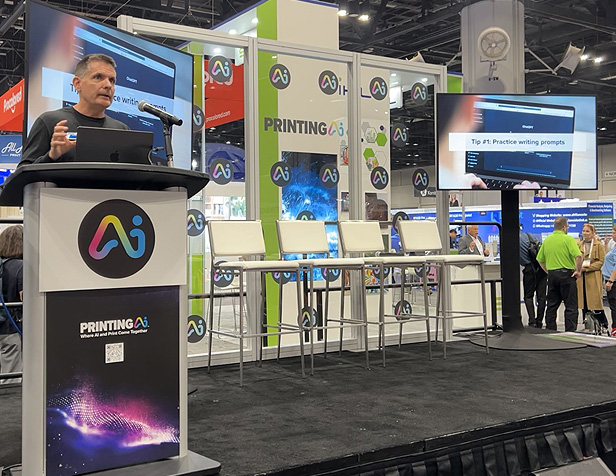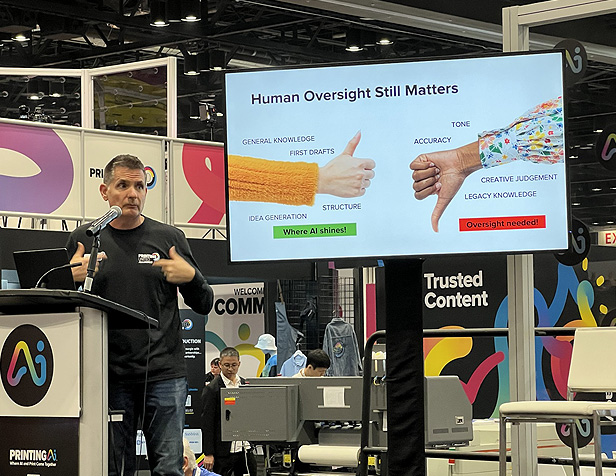Strategy October 23, 2025
PRINTING United Expo 2025: Using AI To Work Smarter & Faster
PRINTING United Alliance’s Joe Marin explained how AI can help or hinder your print and promotional business.
Key Takeaways
• AI is transforming the print industry, but success depends on how well users craft prompts and guide the output. Treat AI like a helpful intern – it needs direction and oversight.
• Effective use of AI requires structured, context-rich prompts. Users should clearly define tone, format and intent, then refine outputs to ensure accuracy and relevance.
• AI-generated content should always be treated as a draft. Like in pre-press work, every output needs review to ensure it meets quality standards and business goals.
“It’s not a fad. It’s here to stay.”
Joe Marin, senior vice president of member services for PRINTING United Alliance, is bullish on AI. Most people are anymore. At this point, it’s not unlike saying you’re bullish on the internet or the combustion engine. It’s just a tech innovation that has fundamentally changed the way we operate, and it is most definitely here to stay.
That said, while people who have acclimated to smartphones, social media, search engine optimization and the general internet age have taken to AI to an extent, not all users have mastered it yet.
It’s like a dance, Marin said during a session at PRINTING United Expo on Oct. 22 in Orlando. It can be complicated and awkward at first, but with a little training and practice, it can be a bit like magic.
Dancing didn’t come naturally to Marin. He had to take a few classes and practice. AI as it relates to his world of print also wasn’t something that just clicked right away. He goes back to the dancing metaphor, remembering when he took dance classes with his wife to get better.
“You don’t just go to learn how to dance, you have to know what kind of dance to do, right?” he asked. “That question matters because every dance has its own steps and rhythms. The same thing goes for AI. You can’t just say, ‘Teach me AI.’ It’s a really big thing.”

The PRINTING United Alliance vice president of member services explained how AI can be a tool for printers and salespeople.
Marin, now with a bit of experience under his belt with popular AI programs like ChatGPT, has a better understanding of how printers, distributors, customer service representatives and other professionals across print and promo can use AI to their advantage and save time and effort.
Crafting Quality Prompts
Marin explained that businesspeople using ChatGPT, or really any generative AI program, often use it for crafting things like emails or marketing copy. This can save time for other tasks or ensure that their marketing message hits the right points. AI, he said, is nothing without the prompt. You could think of AI as the car and you as the driver. It’s only as good as what you put in.
For salespeople, he created examples for a prospecting research input:
“Give me a summary of [Company Name], what they sell, who the customers are and what industries they serve. Focus on what might make them a good fit for my company. Use my website, and the capabilities listed on the site to help.”
Or maybe they want help before a sales call.
“I’m meeting with a boutique beverage brand. Here is their website [copy URL here]. What smart questions can I ask to uncover print needs around packaging, marketing and point of sale?”
Customer service reps can use it, too, for things like explaining intricacies of the print process.
“Explain the difference between aqueous and UV coating, and when you’d recommend each. Keep it brief and clear enough to tell a client.”
Notice that each prompt provides strict parameters about the type of answer the user wants – brief, clear, tone-appropriate and using specific source material.
That’s necessary because these AI programs aren’t actual brains, they’re approximations of a human brain. A “correct” answer isn’t necessarily factually accurate; it’s just an answer that sounds like something a human would say. Marin added that they often can be sycophants, too, complimenting your questions as smart, when in reality, they need work.
Marin outlined a four-step process for creating good prompts:
- Start with what you want: “Write a friendly, personal email”
- Add context: “from a customer service rep to a client”
- Tell it how to format: “email”
- Revise and clarify: “Say: ‘Make it shorter,’ ‘add more empathy,’ ‘use a less formal tone.’”
A Hand on the Wheel of the Self-Driving Car
These little tweaks and revisions are necessary, Marin said. He draws from his experience in the pre-press world, where each job he looked at was basically guilty until proven innocent.
“Every day, I had to assume every file that I got was wrong – everything,” he said. “AI shines in these areas, but when you start going further down that funnel where you’re trying to get more specific information, more granular information, that’s where it gets not as good. It requires more oversight, more checking.”
Marin said each output from an AI model should be treated as a draft. You would never send the first draft of an art job to the decoration process without double-checking everything first. Your AI-assisted emails and marketing copy are the same. You still need to make sure everything’s correct in information, goal and tone.

Marin explained that while AI can save time and effort, it’s not perfect, and users still need to be involved in the process.
This is where Marin said you can put on your managerial hat – the one you’d wear to manage real-life humans.
He likened an AI assistant to a very enthusiastic intern who works 24/7. They’re a wonderful asset, but sometimes you need to double-check their work when they’re overcaffeinated and underslept.
